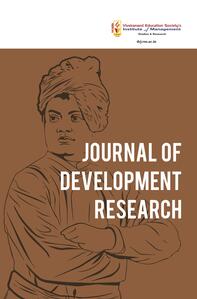
1Sri Krishna Adithya College of Arts and Science, Coimbatore, Tamil Nadu, India
2Dr. G. Ramachandran Library, The Gandhigram Rural Institute-Deemed to be University, Dindigul, Tamil Nadu, India
Creative Commons Non Commercial CC BY-NC: This article is distributed under the terms of the Creative Commons Attribution-NonCommercial 4.0 License (http://www.creativecommons.org/licenses/by-nc/4.0/) which permits non-Commercial use, reproduction and distribution of the work without further permission provided the original work is attributed.
This study examines the Google Scholar profile for Gandhigram Rural Institute. Gandhigram Rural Institute (deemed to be university) has established a Google Scholar profile for their research. The Gandhigram Rural Institute’s faculty publications information was collected from Web of Science and Scopus as of 22 January 2021. After consolidating the data from Web of Science and Scopus, a Google Scholar profile was created. After generating a profile, missing publication data were added to the profile as a sample for the year 2020. The present study information was obtained from Gandhigram Rural Institute Google Scholar profile. It was examined using data from Google Scholar, Web of Science and Scopus. Department publications, Google Scholar citations, the top 15 highly cited papers, and the citations and h-index of the top 15 faculty members were all analysed. It is discovered that ‘Department of Chemistry’ has published 78 (33.77%) publications and has received the greatest number of citations from Google Scholar, 294 (64.19%) citations from Web of Science and 96 (50.79%) citations from the Scopus database. It is found that Faculty S. Meenakshi has received the highest number of 232 (27.10%) citations from Google Scholar, 134 (29.26%) citations from the Web of Science and 47 (28.87%) citations from Scopus. It concluded that having an institution profile in the Google Scholar profile makes it very difficult to update and strengthen all the data in the profile. A Google Scholar profile can be useful as an individual profile if the data are kept up-to-date and maintained.
Google Scholar, h-index, international institutions and organisations, Scopus, Web of Science
Introduction
The productivity of research is most important for higher educational institutions. All higher education institutions now have an internal quality assessment cell (IQAC) that updates institute data on a monthly and annual basis. In an earlier stage, identifying the individual faculty publications was very difficult. The IQAC section requests faculty publications from databases such as Web of Science and Scopus. The purpose of the study is to create a Google Scholar profile for the institute. Based on the profile, it helps submit the faculty publications and metrics to IQAC, NIRF and other accreditations. The institute Google Scholar profile is a very simple, scalable and economical way to track faculty publications from different publisher groups, and these institute profiles give the latest updates on faculty publication alerts. Google Scholar automatically tracks the scholarly output and citation counts of individual researchers, and this facility helps to create a Google Scholar profile for the institute and provides the latest publication information to faculty members, research scholars and students.
Google Scholar makes it simple to search for scholarly literature. From one place, one can search across many disciplines. At the same time, the types of documents are articles, theses, books, abstracts and court opinions, with sources from academic publishers, professional societies, online repositories, universities and other websites. Google Scholar helps one find relevant work across the globe in scholarly research articles. Google Scholar always ranks documents based on the available publication details, as well as those that have recently been cited in other scholarly literature. It provides as many links to an article available on the Internet as free access permits (Google Scholar, 2021). Elango and Bornmann (2021) recently added information on funded details in the Google Scholar search results items. One of the main functions of Google Scholar is to update in all respects. It is an attempt to research and a possible method of gathering data for an institution’s profile.
Features of Google Scholar
Review of Literature
Cortés et al. (2021) compared region-wise development on management and technology with the framework using three bibliographic databases/search engines of Google Scholar, Dimensions and Microsoft Academic. Martín-Martín et al. (2020) investigated Google Scholar found 88% of all citations. Microsoft Academic is the second biggest overall (60% of all citations), including 82% of Scopus citations and 86% of WoS citations. Microsoft Academic and Dimensions are great options in contrast to Scopus and WoS as far as inclusion in many subject categories. Pölönen and Hammarfelt (2020) investigated the historical and linguistic coverage of Google Scholar, using publications in the field of Roman law as an example.
Thoma and Chan (2019) created sample Google Scholar profiles to track the scholarly productivity of five research groups in an institutional, educational research program. It added the publications of each group member to their respective group Google Scholar profiles and monitored the suggested citations. Zientek et al. (2018) discuss the benefits of Google Scholars and the use of Google Scholar to disseminate one’s research using social media. Mingers et al. (2017) collected citations from Google Scholar for all 130 UK universities for evaluation. It compared with various rankings based on 2014 UK Research Excellence Framework (REF) data rankings. The rankings are demonstrated to be dependable and avoid some of the obvious problems of the REF ranking and be highly efficient and cost-effective. Orduña-Malea et al. (2016) attempted to identify specific characteristics of the Google Scholar profile tested in the Spanish academic system.
Tamizhchelvan and Dhanavandan (2015) analysed publications of faculty members in Gandhigram Rural Institute. Haddaway et al. (2015) found that Google Scholar can also find much grey literature and specific, known studies; it may not be used alone for systematic review searches. Rather, it forms a powerful addition to other traditional search methods. In addition, it advocates using tools to transparently document and catalogue Google Scholar search results to maintain high levels of transparency and the ability to be updated, critical to systematic reviews.
Lewandowski (2010) measured the coverage of Google Scholar for the Library and Information Science (LIS) journal literature. It is found that Google Scholar completely indexes only some journals, and the ratio of versions available depends on the type of publisher. The availability of that data varies depending on the article. Google Scholar cannot replace abstracting and indexing services because it does not cover the entire body of literature on the topic. This research differs from previous Google Scholar coverage studies. It takes into account whether or not an article is indexed in Google Scholar at all, as well as the sort of availability. Kulkarni (2009) compared the citation count profiles of articles published in general medical journals among the citation databases of Web of Science, Scopus and Google Scholar. In multivariable analysis, group authorship was the only characteristic that differed among the databases; Google Scholar had significantly fewer citations to group-authored articles (−0.30; 95% CI, −0.36 to −0.23) compared with Web of Science. Web of Science, Scopus and Google Scholar produced quantitatively, and qualitatively different citation counts for articles published in three general medical journals. Kousha and Thelwall (2007) attempted a new approach to finding citation patterns. From their study, Google Scholar citations were more various than ISI references in the four sociology disciplines just as in computer science, recommending that Google Scholar is a more exhaustive tool for citation following in the sociologies and may be like wise in quick fields where conference papers are exceptionally esteemed and distributed on the web. The outcomes for Web/URL citations proposed that counting a limit of one hit for every webpage creates a superior measure for evaluating the effect of open access journals or articles because replicated web citations are very common within individual sites. The results can be considered additional evidence that there is some commonality between traditional and web-extracted citations.
Creation of Google Scholar Profile
Gandhigram Rural Institute (GRI) Google Scholar Profile
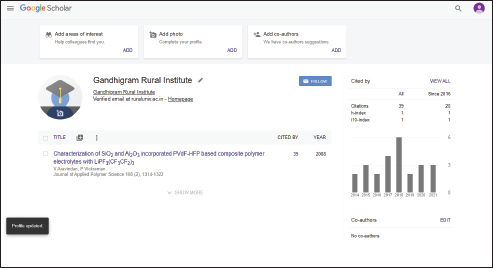
Institute Publications Collecting Methods
Follow this Author
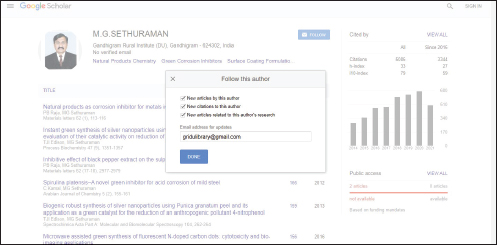
Research Methodology
The data were extracted from Gandhigram Rural Institute Google Scholar Profile (2021) (https://scholar.google.com/citations?user=NnHr3NoAAAAJ&hl=en). The Gandhigram Rural Institute faculty data is taken from the Gandhigram Rural Institute (deemed to be university) (n.d.) website (https://www.ruraluniv.ac.in/). The publication data were collected from the Web of Science and Scopus databases for 2020. The publications from Web of Science and Scopus have been combined, and the final publication data have been uploaded to the Google Scholar profile. The study analyses department-wise publications, citations from Google Scholar, Web of Science and Scopus, the top 15 highly cited publications, the top 15 faculty members’ citations from various databases, and the top 15 faculty members’ Google Scholar citations and h-index.
Objectives of the Study
These are the major objectives of the study.
Data Analysis and Interpretation
The data have been analysed based on publications and citations by department, highly cited articles and top-ranked 15 faculty members.
Department-wise Publications
Table 1 shows the department-wise publications of the Gandhigram Rural Institute Google Scholar Profile. It is found that the ‘Department of Chemistry’ has published 78 (33.77%) publications and placed first. It is followed by the ‘Department of Physics’, which has published 45 (19.48%) publications and is in second place. It is further found that the ‘Centre for Applied Research’, ‘Department of Economics’ and ‘Department of Home Science’ have published the least number of publications and are in the fourteenth position.
Table 1. Department-wise Publications.

Department-wise Citations from Various Databases (Google Scholar, Web of Science and Scopus)
Table 2 indicates department-wise citations from various databases (Google Scholar, Web of Science and Scopus). It is found that the ‘Department of Chemistry’ has received the highest number of 478 (55.84%) citations from Google Scholar, 294 (64.19%) citations from Web of Science and 96 (50.79%) citations from the Scopus database and placed first. It is followed by the ‘Department of Physics’, which has received 151 (17.64%) citations from Google Scholar, 87 (19.00%) citations from the Web of Science and 41 (21.69%) citations from the Scopus database, placing it in second place.
It is further found that ‘Centre for Applied Research’, ‘Department of Economics’, ‘Department of Home Science’ and ‘Department of Library’ have received a lower number of citations from Google Scholar. It is further found that ‘Centre for Applied Geology’, ‘Centre for Applied Research’, ‘Centre for Rural Technology’, ‘Department of Economics’, ‘Department of Fine Arts’, ‘Department of Home Science’ and ‘Department of Library’ have received the least number of citations from the Web of Science database and are ranked ninth. It is further found that ‘Centre for Applied Research’, ‘Centre for Geoinformatics’, ‘Centre for Rural Technology’, ‘Department of Economics’, ‘Department of Home Science’, ‘Department of Library’ and ‘Department of Rural Industries and Management’ have received fewer citations from Scopus and placed in the tenth rank.
Table 2. Department-wise Citations from Various Databases.
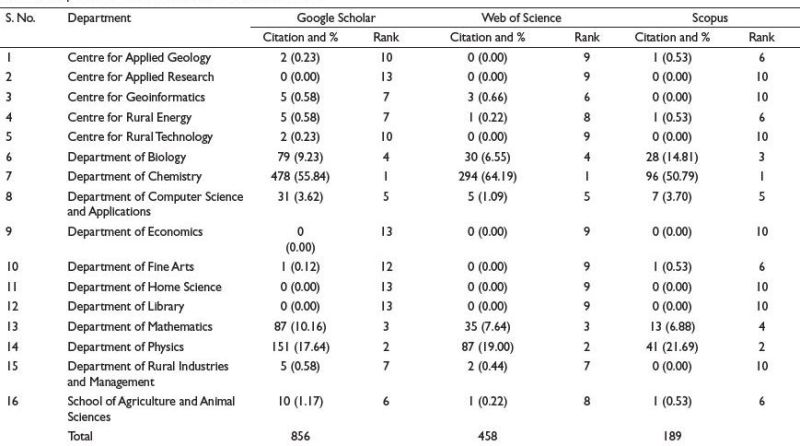
Table 3. Top 15 Highly Cited Articles.
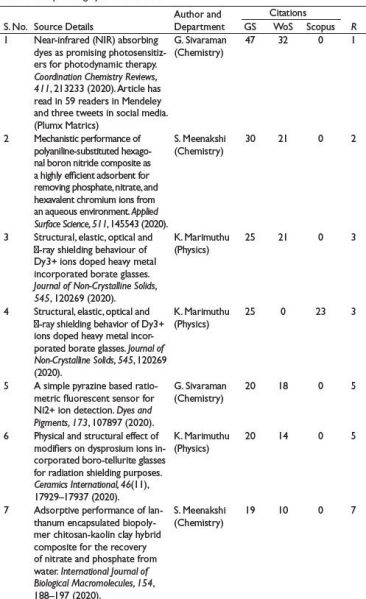


Note: GS: Google Scholar; WoS: Web of Science.
Top 15 Highly Cited Articles
Table 3 indicates the 15 most highly cited articles. It is found that ‘Near-infrared (NIR) Absorbing Dyes as a Promising Photosensitizer for Photodynamic Therapy’ has received 42 citations from Google Scholar and 32 citations from the Web of Science and shared two altmetric scores that have placed it in the first rank, followed by ‘Mechanistic Performance of Polyaniline-Substituted Hexagonal Boron Nitride Composite as a Highly Efficient Adsorbent for the Removal of Phosphate, Nitrate, and Hexavalent Chromium Ions from an Aqueous Environment’ (placed second), which received 30 citations from Google Scholar and 21 citations from the Web of Science. It was discovered that the papers ‘Tunable Electrochemical Synthesis of 3D Nucleated Microparticles Like Cu-BTC MOF-Carbon Nanotubes Composite: Enzyme Free Ultrasensitive Determination of Glucose in a Complex Biological Fluid’ and ‘Sol–Gel Based Hybrid Silane Coatings for Enhanced Corrosion Protection of Copper in Aqueous Sodium Chloride’ received 13 citations from Google Scholar and ten citations from Web of Science, respectively, and were ranked 14th.
Top 15 Faculty Members’ Citations for the Year 2020
Table 4 shows the top 15 faculty member citations. It is found that ‘S. Meenakshi’ has received the highest number of 232 (27.10%) citations from Google Scholar, 134 (29.26%) citations from the Web of Science and 47 (28.87%) citations from Scopus and placed first. It is followed by ‘K. Marimuthu’, who has 100 (11.68%) citations from Google Scholar, 52 (11.35%) citations from the Web of Science and 26 (13.76%) citations from the Scopus database, and is ranked second. It is also discovered that ‘G. Mahadevan’ has received fewer citations from Google Scholar and is near the bottom of the list on Web of Science. It is further found that ‘S. Abraham John, ‘P. Nithiananthi’ and ‘G. Nagamani’ have received the least number of citations and are ranked 13th.
Table 4. Top 15 Faculty Members Citations for the Year 2020.

Table 5. Top 15 Faculty Google Scholar Citations and h-Index.

Table 6. The Collaboration of Gandhigram Rural Institute with Other Institutions.

Top 15 Faculty Google Scholar Citations and h-Index
Table 5 indicates the top 15 faculty members by Google Scholar, Web of Science, Scopus citations and h-index. It is found that ‘P. Balasubramaniam’ has received the highest number of 8,251 Google Scholar citations with a 50 h-index and has placed the first rank; it is followed by ‘S. Meenakshi’, who has received 7,495 Google Scholar citations with a 46 h-index and has placed the second rank. It is further found that ‘G. Mahadevan’ has received less than 419 Google Scholar citations with a 10 h-index and is ranked 14th.
It is discovered that ‘P. Balasubramaniam’ has received 6,673 citations from Scopus with a 46 h-index and is ranked first. It is followed by ‘S. Meenakshi’, which has received 5,968 Scopus citations with a 40 h-index and placed second. It is further found that ‘G. Mahadevan’ has received less than 144 Scopus citations with an 8 h-index and is ranked 15th.
Table 7. Authorship Pattern.
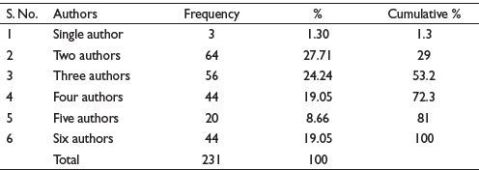
It is found that ‘P. Balasubramaniam’ has received the highest number of 5,723 Web of Science citations with a 43 h-index and has placed first and it is followed by ‘S. Meenakshi’, who has received 5,249 Web of Science citations with a 38 h-index and has placed second. It is also discovered that ‘Balasubramanian Malaikozhundan’ has only 56 Web of Science citations with 4 h-index and is ranked 14th.
The Collaboration of Gandhigram Rural Institute with Other Institutions
Table 6 reveals the collaboration of Gandhigram Rural Institute with other institutions. Table 6 shows that Gandhigram Rural Institute collaborated with institutions in the Web of Science and Scopus. The study reveals that the authors of Gandhigram Rural Institute collaborated on 8 (4.19%) Scopus publications with Alagappa University, Pocker Sahib Memorial Orphanage College, followed by Madurai Kamaraj University (6 (3.14%) publications), Vishwabharathi College of Pharmaceutical Sciences and Yeungnam University (2 (1.05%) publications).
The study reveals that the authors of Gandhigram Rural Institute collaborated on 9 (6.67%) Web of Science publications with Alagappa University, followed by Madurai Kamaraj University, Pocker Sahib Memorial Orphanage College (6 (4.44%) Web of Science publications). It is further found that Gandhigram Rural Institute authors collaborated on 2 (1.48%) publications at Anna University and Chonnam National University.
Authorship Pattern
Table 7 indicates the authorship pattern of Gandhigram Rural Institute Google Scholar author profiles. Out of 231 publications, 64 (27.71%) were contributed by two authors, followed by 56 (24.24%) were contributed by three authors. The most accepted type of collaboration was notably between two authors, three authors, four authors and six authors.
Conclusion
In the current scenario, Google Scholar profiles are important for academic and higher learning institutions, and Google Scholar provides profile metrics like publication citations, h-index and i10-index. Anyone can create a Google Scholar account, even if one does not have an article published that has been indexed in the citation database but has been published in an online journal. Then he may receive citations through Google Scholar. Google Scholar recently added funding publication details to the Google Scholar profile. The profiles of institutions in Google Scholar are extremely difficult to update and strengthen with all of the data. The Google Scholar profile is a good individual profile if its data is kept up-to-date and maintained and if it has a high impact. The Google Scholar profile helps to submit the faculty publications and metrics to IQAC, NIRF and other accreditations, and these institute profiles give the latest updates on faculty publication alerts and help to provide the latest research activities to faculty members, research scholars and students.
Declaration of Conflicting Interests
The authors declared no potential conflicts of interest with respect to the research, authorship and/or publication of this article.
Funding
The authors received no financial support for the research, authorship and/or publication of this article.
Cortés, J., Lin, X., & Xun, X. (2021). Research on innovation in business and management about China and Latin America: Bibliometric insights using Google Scholar, Dimensions and Microsoft Academic. The Chinese Economy, 15–19. https://arxiv.org/ftp/arxiv/papers/2104/2104.06437.pdf
Elango, B., & Bornmann, L. (2021). Letter. New Google Scholar section with information on funded publications. El Profesional de la infor-mación, 30(3),1–7.
Gandhigram Rural Institute-Google Scholar Profile [Internet]. (2021). https://scholar.google.com/citations?user=NnHr3NoAAAAJ&hl=en
Google Scholar [Internet]. (2021). Scholar.google.com. https://scholar.google.com/intl/en/scholar/about.html
Haddaway, N., Collins, A., Coughlin, D., & Kirk, S. (2015). The role of Google Scholar in evidence reviews and its applicability to grey literature searching. PLOS ONE, 10(9), 1–17.
Kousha, K., & Thelwall, M. (2007). Google Scholar citations and Google Web/URL citations: A multi-discipline exploratory analysis. Journal of the American Society for Information Science and Technology, 58(7), 1055–1065.
Kulkarni, A. (2009). Comparisons of citations in Web of Science, Scopus, and Google Scholar for articles published in general medical journals. JAMA, 302(10), 1092–1096.
Lewandowski, D. (2010). Google Scholar as a tool for discovering journal articles in library and information science. Online Information Review, 34(2), 250–262.
Martín-Martín, A., Thelwall, M., Orduna-Malea, E., & Delgado López-Cózar, E. (2020). Google Scholar, Microsoft Academic, Scopus, Dimensions, Web of Science, and OpenCitations’ COCI: A multidisciplinary comparison of coverage via citations. Scientometrics, 126(1), 871–906.
Mingers, J., O’Hanley, J., & Okunola, M. (2017). Using Google Scholar institutional level data to evaluate the quality of university research. Scientometrics, 113(3), 1627–1643.
Orduña-Malea, E., Ayllón, J., Martín-Martín, A., & Delgado López-Cózar, E. (2017). The lost academic home: Institutional affiliation links in Google Scholar citations. Online Information Review, 41(6), 762–781.
Pölönen, J., & Hammarfelt, B. (2020). Historical bibliometrics using Google Scholar: The case of Roman Law, 1727–2016. Journal of Data and Information Science, 5(3), 18–32.
Tamizhchelvan, M., & Dhanavandan, S. (2015). Analysis of the publications of the Gandhigram Rural Institute: A bibliometric study. SRELS Journal of Information Management, 52(6).
The Gandhigram Rural Institute-Deemed University [Internet]. (n.d.). Ruraluniv.ac.in. https://www.ruraluniv.ac.in/
Thoma, B., & Chan, T. (2019). Using Google Scholar to track the scholarly output of research groups. Perspectives on Medical Education, 8(3), 201–205.
Zientek, L., Werner, J., Campuzano, M., & Nimon, K. (2018). The use of Google Scholar for research and research dissemination. New Horizons in Adult Education and Human Resource Development, 30(1), 39–46.